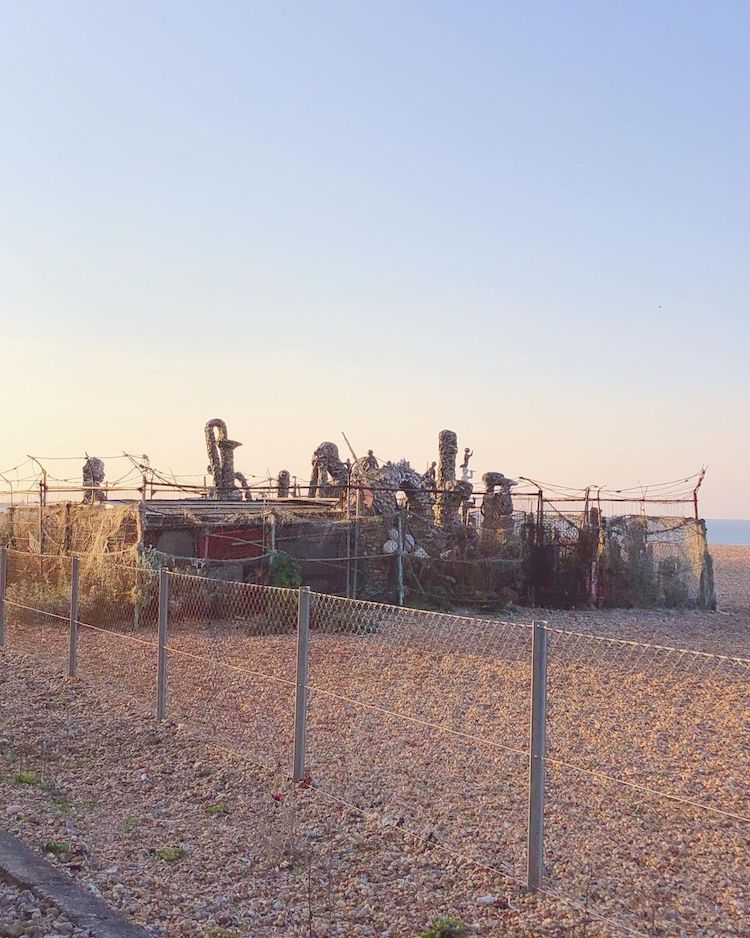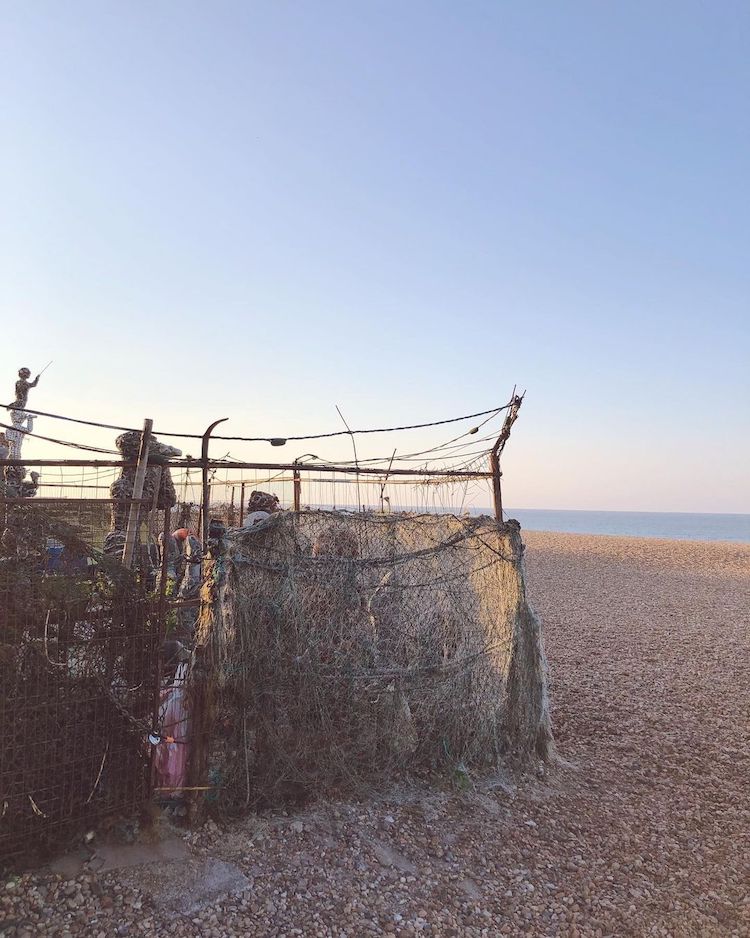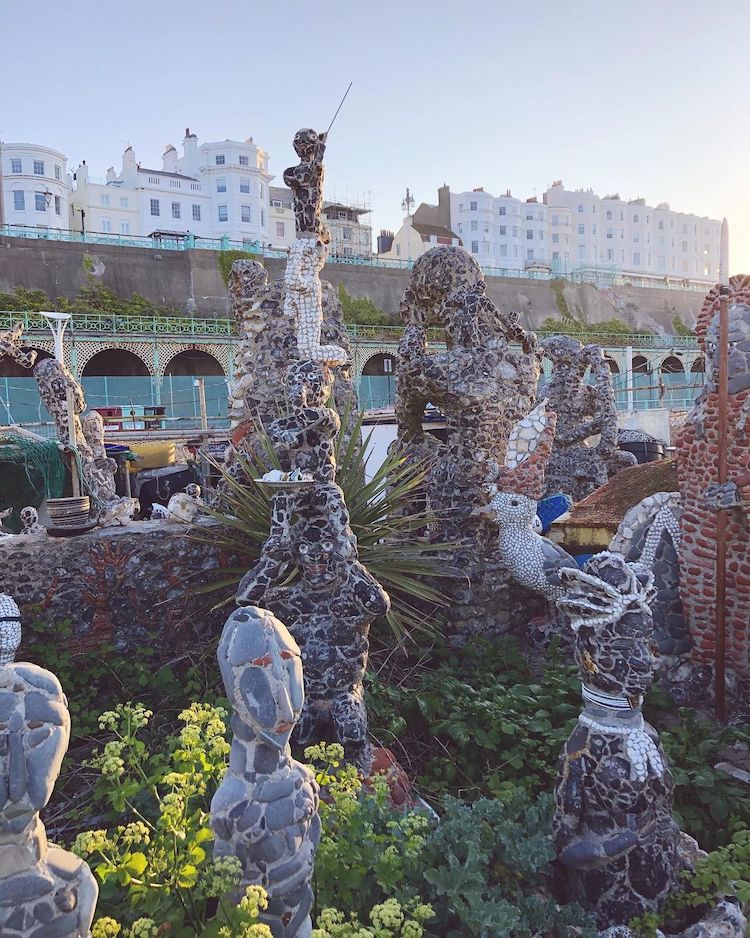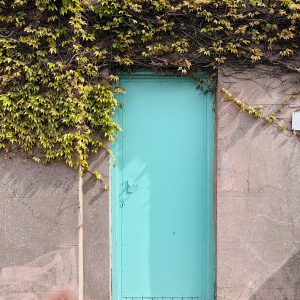
When it comes to looking at art in Brighton, the off-beat English seaside city known for its creative spirit, you can’t walk five minutes without passing an independent gallery. There’s no doubt these great little places champion and nurture the talents of our local artists, and are fun to hop around, but there’s an ‘art gallery with a twist hiding in plain sight on Brighton beach I want to show you.

I know what you’re thinking though. “Hang on! That doesn’t look like an art gallery? That looks like a fenced of hunk o junk, filled with rubbish and old fishing nets!” Well, yes, I agree it doesn’t look like a traditional art gallery. And yes, you would not be the first person to consider walking past it without giving it a second thought, dismissing it as nothing in particular. However, look closer, and you’ll see that hidden within is a magical collection of sculptures – some up to eight-foot-high – of figurines decorated beautifully in flint and shells from the beach.

Let me give you a moment to take it in the sight of this curious collection of ancient-looking statues. Don’t they wear the pink light of the morning well? When I spotted them bathed in the sunrise on a recent morning run, I just had to stop to capture them, even though it involved risking losing my iPhone, as I precariously snapped through gaps in the fence.
The collection includes eight larger-than-life sculptures. Some have a link to ancient mythology while others are inspired by Bronze and Iron Age art. One of the most recent additions is a sculpture inspired by the Venus of Willendorf – a 25,000-year-old piece of artwork considered to be one of the oldest and most famous surviving works of art in the world. Another represents a Sumerian goddess cradling a child. There are also smaller non-figurative sculptures, such as a grave containing a skeleton, a throne and an entryway.

This mysterious collection has become known locally as the ‘flint grotto’, great name! It was created almost by accident by a local man and self-taught artist – although he doesn’t see himself as an artist – Rory McCormack. He’s also often referred to as the ‘last fisherman’, not because he was a professional fisherman. In Brighton, there was a time when local people fished to keep the fridge full and the neighbours fed, as recently as 20 years ago. Originally the beach was lined with these little council-owned plots locals used to store their fishing gear in, but they kept getting vandalised, so the council tore them all down – except Rory’s, which he’s held on to fervently ever since, the metal lock-up obscured by his creations.

Rory moved to Brighton with his family in the 1960s when he was just six years old, began fishing off Brighton beach as young as 16. The project to build sculptures happened totally by accident. The story goes that he built a workbench out of material he found on the beach: the flint pebbles and shells, and the project grew up around it. “I thought it was a good way to make use of some of the stuff that I had just lying about at home,” he told me.

McCormack began creating his sculptures without asking permission, which has led to him being described as an ‘outsider artist’, which he doesn’t agree is entirely accurate. “Nearly all of them at the time were experiments,” he tells artist David Clegg, in an interview for The Keepers Project*, which documents threatened environments made by self-taught artists, like Rory.
“What will these look like if I put a few shells here, what will this look like if I make it flat instead of curved…The whole thing is an experiment… It’s putting things together… there’s no ulterior motive… it’s never intended to make money, that would be incidental. It’s of its place and of its time…Brighton despite its veneer of entertainment, was originally formed of fishing and farming folk…The beach was used by a working-class community with a long history of fishing, which is dying out… this place represents that time.”


Rumour has had it for a long time that the council is poised to demolish the sculptures, deeming them a health and safety risk, although this isn’t technically true he says. “One council official did mention something at one time, but I haven’t heard anything since and that was a few years ago… I have no idea what will happen here. Essentially it’s owned by the public, and as soon as I built anything here it’s owned by the public, for them to enjoy. I wouldn’t expect to get anything out of it… ”

Oh, but before you go, let’s not overlook Rory’s fishing boat, also a work of art. “For some reason, people have stopped decorating their boats… I don’t know why because people get romantically carried away with their boats… it’s their escape… at one time, especially professional fisherman, you would get a sign-painter to at least do the name.”
Discover the ‘flint grotto’ along Madeira Drive, Brighton, or read more about it in Secret Brighton.
* The Keepers Project is a collaboration between artist David Clegg and photographer Thierry Bal which documents threatened environments made by self-taught artists. It includes interviews with the artists – or those preserving their legacy – alongside photography of each environment, which you browse as you listen to the interview. Hear their interview with Rory, here.
New to Ellie & Co? Join thousands more and sign up for my monthly newsletter. Or follow my stories on Instagram, Twitter or Facebook.



